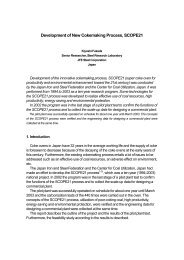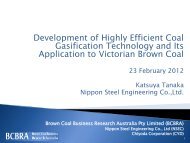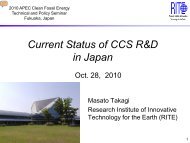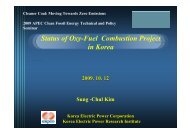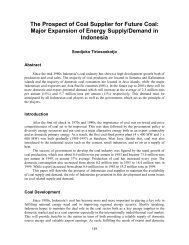Defining CCS Ready: An Approach to An International Definition
Defining CCS Ready: An Approach to An International Definition
Defining CCS Ready: An Approach to An International Definition
- No tags were found...
You also want an ePaper? Increase the reach of your titles
YUMPU automatically turns print PDFs into web optimized ePapers that Google loves.
Chapter 3: Transport <strong>Ready</strong> Plant <strong>Definition</strong>Exhibit 3-4: Illustrative Example of Requirementsfor Commercial Transportation of CO 2Type ofLimitLimit(Permian Basin)ConstituentReason for ConcernCO2 Min 95% Minimum miscible pressure for EORNitrogen Max 4% Minimum miscible pressure for EORHydrocarbons Max 5% Minimum miscible pressure for EORWater Max 30 lbs/MMcf CorrosionOxygen Max 10 ppm CorrosionH2S Max 10-200 ppm SafetyGlycol Max 0.3 gal/MMcf OperationsTemperature Max 120 deg F MaterialsSource: INGAA Foundation, 2009As an example of the need <strong>to</strong> address environmental and safety approvals, the UK <strong>CCS</strong><strong>Ready</strong> Regulations recommend applicants:• “confirm that no unavoidable safety obstacles exist within the identified route corridor,on the basis of current knowledge about the hazards posed by CO 2 transport;”• “suggest methods by which the environmental impacts on an unavoidable designated sitewithin the route corridor could be mitigated on the basis of current knowledge at thetime of the feasibility study.”• “inform the local planning authorities in the areas surrounding the power station of thelikelihood that a CO 2 pipeline will be needed in the future <strong>to</strong> ensure this is taken in<strong>to</strong>account in local planning decisions”• “treat CO 2 as a ‘Dangerous Fluid’ under the Pipeline Safety Regulations (PSR) whenconsidering CO 2 pipeline design and route at the CCR stage. Applicants are advised <strong>to</strong>check with Health and Safety Executive (HSE) for updates <strong>to</strong> this guidance, applying aprecautionary principle that classifies CO 2 as if it were a “Dangerous Fluid” under thePSR when considering CO 2 pipeline design.”• [in the event CO 2 will be shipped] ...“consider and demonstrate there are no barriers <strong>to</strong>their complying with all the relevant safety fac<strong>to</strong>rs involved in loading a dangerous fluidon<strong>to</strong> a ship. The Marine and Coastguard Agency are responsible for the safety regulationon ships and their regulations should be consulted. Harbour orders are likely <strong>to</strong> berequired for the construction of facilities <strong>to</strong> load CO 2 onboard ships.” 7676 Paragraphs 59 and 60, pg. 22; paragraph 61, page 23; and paragraph 89, pg. 31 of U.K. Department of Energy andClimate Change (U.K. DECC). (2009a). Carbon capture readiness (CCR): A guidance note for Section 36 Electricity Act1989 consent applications (Publication no. URN 09D/810). London, UK: Author.23 February 2010 43




